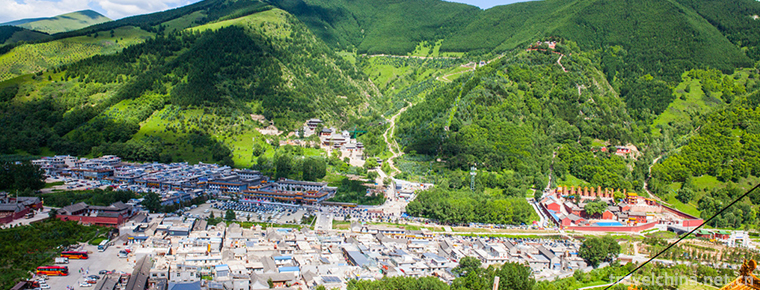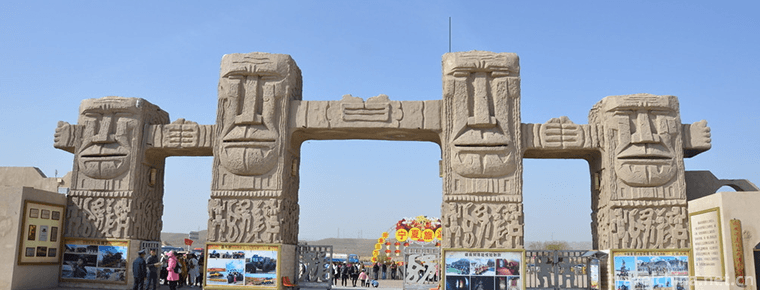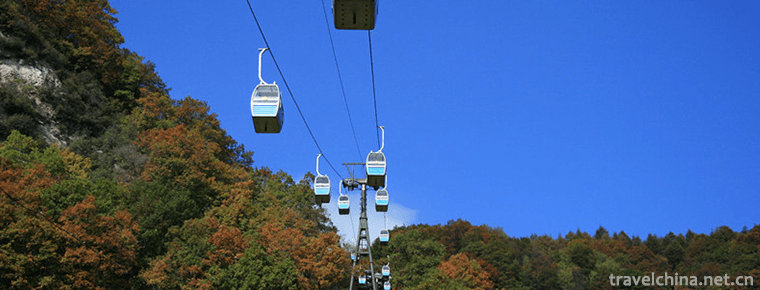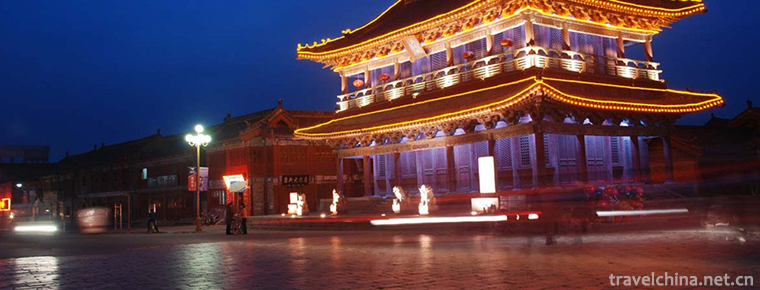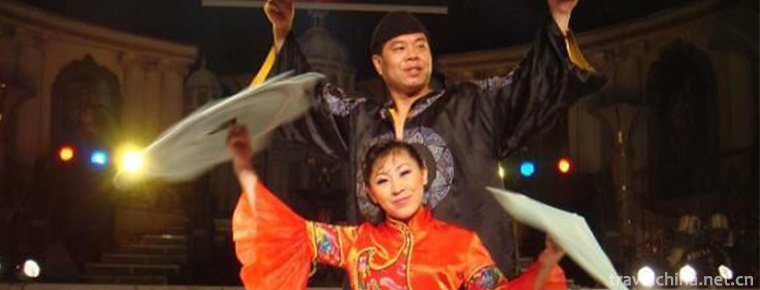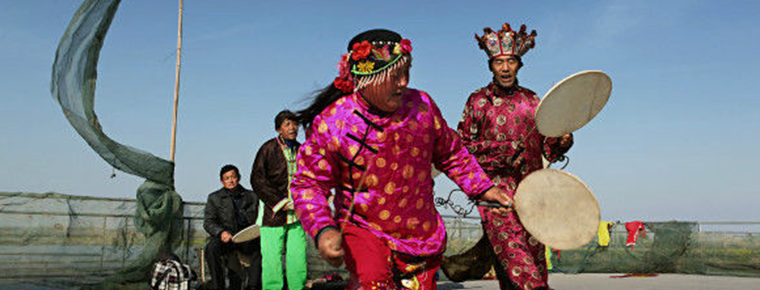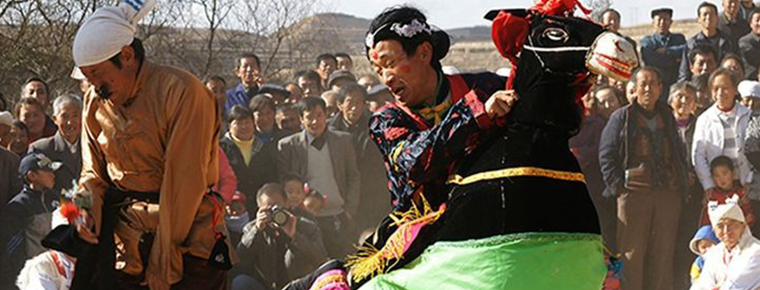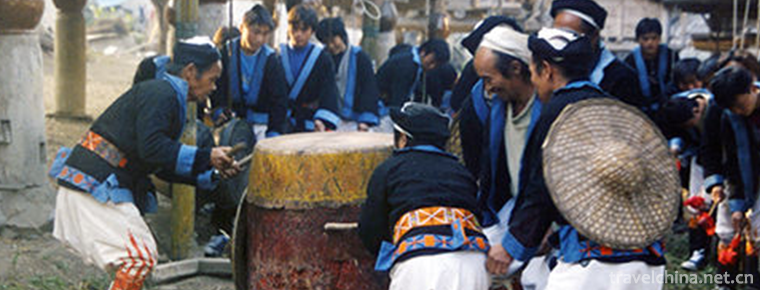Stilts
Stilts
Stilts, also known as "Stilts Yangko", is a folk dance widely spread throughout the country. It is named for its many feet on stilts when dancing. Stilts have a long history, originating from a kind of technical performance in ancient hundred operas. In the Northern Wei Dynasty, there were stone portraits of stilts. Stilts were usually performed in the form of dance teams, with a number of more than ten to dozens of people. Most dancers played roles in an ancient myth or historical story, and their costumes mostly imitated Opera performances. The commonly used Taos had fans, handkerchiefs, wooden sticks, knives and guns, etc. There are two kinds of performances, namely "stepping on the street" and "abandoning the field". The abandonment stage includes the "big field" with various formation patterns and the "small field" with two or three performances. The roles are mostly performed by men and women, sometimes singing while dancing. The wooden stilts used everywhere ranged from 30 cm to 300 cm in height. From the performance style, it can be divided into "Wenqiao" and "Wuqiao", Wenqiao twisting and trampling and plot performance; Wuqiao dazzling skills.
On May 20, 2006, stilts were listed in the first batch of national intangible cultural heritage list with the approval of the State Council.
Historical evolution
According to the article "Liezi Shuofu", it is recorded that "those who have orchids in Song Dynasty have branches in Song and Yuan Dynasty. Song, Yuan and Taiwanese saw its branches. He believed in his body with two long branches and belonged to his tibia. He ran side by side and jumped with seven swords. Five swords were often in the air. The emperor of Yuan was shocked and set up a gold silk. It can be seen from the article that stilts were popular among the people as early as the Pre-Qin Dynasty.
In his poem Yong Yangge, En Zhuqiao of the Qing Dynasty also described the stilt-walking activities during the Spring Festival at that time: "Quick foot, high in line, promised to join Cao quickly. Laugh at him for standing on his feet and walking around the world once." This poem fully illustrates that stilts, a folk art, had been widely spread among the people in the Qing Dynasty.
According to folklore, stilts originally evolved into today's stilts art after ancient people tied two long sticks to their legs in order to collect wild fruits from trees for food.
Some legends have it that stilts were created by folk fire artists. Legend has it that there is a year of Lantern Festival, and artists from all villages unite to make a scene in the county town. Knowing this, the Master of Zhixian wanted to make a fortune by committing fraud, and ordered the four-door suspension bridge to be lifted. Those who entered the city had to pay the bridge fee, otherwise they would not enter the city. After listening to the outdoor firefighters, they were very angry, but they could not help it. Then he gathered up enough money to go to the city. Who knows that the county Lord has raised the price of the money to cross the bridge into the city again, and the son of the commune fire leader is clever, resourceful and bold. When I got home, I saw the picture of the long-legged white crane hanging on the wall inspired, so I rushed to make wooden sticks overnight, put pedals on the sticks, tied the sticks to my legs, and tied my feet to the pedals, and exercised a circle along the city during the night to cross the moat the moat. On the fifteenth day of the first lunar month, the fire brigades outside the city tied up their legs and lined up to cross the moat, entered the city and made a scene of fire. The County Lord was annoyed by the incident. Some people say that this is the prototype of stilts.
There is also a legend that stilts were created by General Gao, who won the battle against the enemy. One year, General Gao led his troops to attack Hubingcheng Pool, and Hubing tore down all the suspension bridge slabs on the moat, so the troops could not enter the city. One evening, General Gao stepped out of the barracks and suddenly saw the long legs of the geese looking for food by the river. He was inspired to find a way to break the city. After returning to the camp, the general ordered people to cut willow sticks to make stilts, so that the soldiers were tied to their legs to practice walking. After practice, soldiers can walk on tall willow sticks. The general led his troops across the moat and took Hu's troops unprepared. He attacked the city and recovered the city pool in one fell swoop. Since then, every Spring Festival, people have learned to step on willow sticks. Since this was invented by General Gao, people called it Stilts in memory of General Gao.
Style and characteristics
Selection of props
Stilt props are simple, but wood selection is exquisite. Hard and tough wood must be used.
If elm, Sophora is still good, willow is next, rotten wood is not available. The selected wood is processed into 4-15 feet long sticks by carpenters. The sticks are flat and round, and the pedals are set according to the height of stilts. Generally, the device is more than 3 feet. Individual places are five or six feet high. Stilts are usually made of cloth, so that they can be tied tightly without stirring their legs or feet.
Image setting
The earliest characters they played were fisherman, matchmaker, fool, second brother, Taoist aunt and monk. With the change of times, the characters of stilts are mostly characters in traditional Chinese opera and folktales, such as Liu Bei, Guan Yu, Zhang Fei and Kongming in the romance of the Three Kingdoms; Tang Seng, Sun Wukong, pig eight quit, sand monk in the journey to the West; and the Eight Immortals in * Ji, monk, little immortal and "Eight Immortals crossing the sea". After the founding of the People's Republic of China, people of the time, such as workers, peasants, soldiers, academics, businessmen and family planning, were put on stilts. The performer's costume is funny and humorous. They sang and performed vividly. There are stilts, the actors are holding a small gong with a diameter of 78 inches while walking and knocking, and step-by-step, issued a "single blocking, single blocking, single blocking, single blocking" Gong sound. The Gong rotates freely in the hand, sometimes throwing and knocking, which is very interesting. So people make up a line to say, "Stop alone, come and hide on stilts, step on you and buy two or two fruit peels."
Costume props
It's based on the character of the stilt walker. If Sun Wukong wears monkey clothing, wears a hoop cap and a Golden hoop, the pig takes the big iron rake, and the Kung Gong monk holds a brush or broken fan. The old woman takes a long rod tobacco bag, and the Kung Fu hand makes the green dragon moon cutter. In short, clothing and props are made according to the characters in the story.
Performance formation
There is a long word snake, walk eight characters, double-row duet, cross scissors, snake peeling and other formation.
The movements of the performances include crutching, back crutching, fork falling, jumping tables and benches, turning over, squatting, kite turning over, one-legged jumping. They can also form many kinds of performances, such as two-person car lift, three-person car pulling, group overpass, horse pulling and so on. Stilt shows are highly skilled and difficult, but they can perform beautifully, vividly, funny, strange and thrilling, and are very popular with the audience.
Music accompaniment
Stilts are accompanied by folk gongs and drums. The pace of stilts depends entirely on the speed of the gongs and drums orchestra to direct the performance of stilts.
Inheritance status
Gaoyou Linze Stilts
Declaration area or unit: Linze Town, Gaoyou City
Linze Stilts is a famous folk cultural activity in Linze Town, Gaoyou City. It has the elements of traditional opera and acrobatics. Linze stilts have inherited more than 450 years of history, which began in the Ming Dynasty, developed in the Qing Dynasty, flourished in the Republic of China, revived in the 1980s, and now belongs to the list of intangible cultural heritage in Jiangsu Province.
Linze stilts were selected for the opening ceremony of the first Chinese Farmers'Art Festival and won excellent program awards. In addition, they were invited to participate in the performances of Yangzhou World Canal Expo, China Post Culture Festival and China Double Yellow Duck Egg Festival held by Gaoyou City, which are very popular.
On February 12, 2014, Linze Stilts performed for the wife of the President of Egypt and the wife of the ambassadors in Egypt at the Chinese Embassy in Cairo.
Stilts
Declaration area or unit: Jishan County, Shanxi Province
Stilt animal art is a kind of performance form of temple fair cultural activities in Yangcheng Village, Qinghe Town, Jishan County, Shanxi Province.
It prevailed in the early years of Yongzheng in the Qing Dynasty, and appeared in large-scale temple fairs. It has a long history of more than 300 years.
Stilt beasts are composed of animal heads, animal bodies and performers. During the performance, two people walk on stilts and ride beasts together. The performers bear heavy loads and walk at the rhythm of the music cards. Auxiliary music consists of percussion instruments such as gongs, drums and flower drums. Man and beast have peculiar shapes. They are magnificent and magnificent when marching in line with the sound of drums and music. The existing animal images are basically handed down from ancient times, although they have been repaired many times, the original appearance still exists. Its head and body are modeled by highly skilled artists, sewn and bound with hemp silk, hemp paper, string, fine bamboo, wire, cloth, etc., and painted in various colors, with a powerful and exquisite appearance. Yangcheng Village of Qinghe Town in Jishan County is divided into Nanyang City and Beiyang City. The animals of Beiyang City include unicorn, mink wolf, unicorn, bamboo horse, cat, etc. The animals of Nanyang City include black civet tiger, Sika deer, tapir and so on.
Stilts in Haicheng
Declaration area or unit: Haicheng City, Liaoning Province
Haicheng stilt Yangko has a long history. The literature of Qing Dynasty shows that it has a history of more than 300 years.
At the end of Qing Dynasty, Haicheng stilts became mature day by day, forming a professional and semi-professional artist team. Artists have their own unique skills, so their pedigree of inheritance is spectacular. From the first generation of Xiaojin and Dalaizi in 1820 to the second generation of red, pink, yellow, blue, white and green chrysanthemums in 1887, Zhang Jiurong in 1902, Wu Kui-yi in 1940 and Wang Fengxiang in 1940, Wang Liancheng in 1951 and Chen Shiyou in 1970 and the sixth generation. Sheng, Qin Li (Xiaodan) and so on, there have been many outstanding stilt artists.
Haicheng stilt Yangko is a popular folk dance. Its keynote is joy, unrestrained, warm and popular. Its characteristics are gracefulness, lyricism, wit and jocularity. The unification of the two forms the artistic characteristics of Haicheng stilt Yangko, which derives the four technical elements of twisting, wave, amusement and facial expression. In the performance of Haicheng Stilt Yangko, the Grand Arena and the light and delicate small arena include music, dance, acrobatics, opera and other forms, forming a comprehensive folk square art with dance as the main body. Haicheng stilt Yangko has a wide influence not only in the local area, but also at home and abroad. In 1988, it won the first prize in the National Plaza Folk Dance Competition. Since 1997, it has participated in various grand performances at home and abroad. Its performance is unique and shows the characteristics of stilt Yangko in Northeast China.
Stilts in western Liaoning
Declaration area or unit: Jinzhou City, Liaoning Province
According to the historical data, the stilt Yangko in Western Liaoning has a history of more than 200 years.
The characteristics of stilted Yangko in Western Liaoning Province are stilted, with the lowest 90 cm, rising in turn, and the highest up to 240 cm.
Actors need to sit on the eaves and straddle their legs. Because the stilts are flexible and full of elasticity, in order to maintain the balance of the whole body, dancers must swing their arms up and down continuously in order to perform freely, thus constituting the basic rhythm of "great dance" on stilts in Western Liaoning Province. Because of the stilts, the Yangko on stilts in Western Liaoning has formed such skills as throwing, straddling, squatting, breaking, twisting and other forms as beauty, wave, beauty, dazzling and teasing. Its movements are natural and beautiful, and the scenes are warm and explosive. It has prominent performance characteristics such as twisting China and the United States, Chinese waves, waves, dazzling and teasing. It fully demonstrates the heroic character of the people in Western Liaoning.
The stilt Yangko in Western Liaoning has its own unique way of inheritance. One is the family inheritance, such as Zhu Xiufeng (born in 1840), the first generation of Santun Village, Daxue Township, who passed down five generations; the second is the inheritance of teachers and apprentices, such as Zhu Youyu (born in 1864), the first generation of Fantun Village, Yingpan Township, who passed down four generations; and the third is the natural inheritance.
Bitter Water Stilts
Declaration area or unit: Yongdeng County, Gansu Province
Kushui Street stilts in Yongdeng County, Gansu Province, originated in the late Yuan and early Ming Dynasty, and have a history of nearly 700 years. Stilts are a folk performing art handed down from generation to generation in the local area, and also a traditional reserved program in the February 2nd lunar month dragon head up social fire. The performers dressed in traditional theatrical costumes, painted the faces of the characters in the Qin Opera, took props, stepped on stilts, and lined up to perform in the street under the guidance of the powerful Taiping Drum Team. The height of stilts in bitter water is 3 to 3.3 meters, ranking the highest in the country.
Inheritance significance
Stilt animals, a folk dance activity, enriches the people's spiritual and cultural life, strengthens the unity and harmony between people, and also reflects the local people's desire for good weather and good harvest in agriculture. Nowadays, stilt animals, as a folk dance activity, are facing the situation of being green and yellow. Effective measures are urgently needed to implement rescue and inheritance.
Haicheng stilt Yangko has been a brilliant time in history and has been inherited by the people. However, due to the death of some veteran artists and the lack of successors, their performing skills are facing the danger of loss, and need urgent rescue and protection.
The stilt Yangko in Western Liaoning Province has important cultural and artistic value, and has a wide influence on the local people as well as inside and outside the province. Due to the death of some old artists of stilted Yangko in Western Liaoning and the lack of successors, their performing skills, especially the unique "super stilts" in the country, are facing the danger of losing their heritage and are in urgent need of rescue and protection.
In the face of inheritance dilemma, performers'psychological instability and survival crisis of dance species, relevant departments need to invest financial, human and material resources to explore and protect.

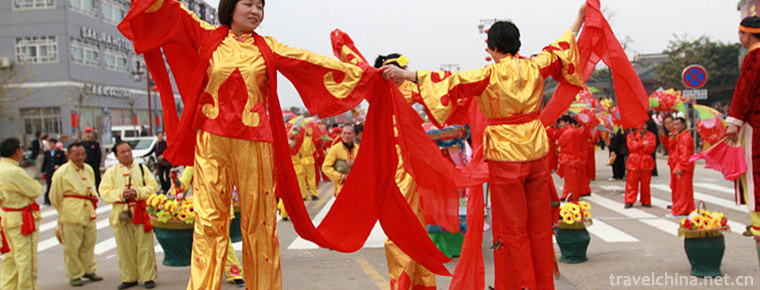
-
Lingwu Shuidonggou Tourist Area
Shuidonggou Ancient Human Culture Site is located in Shuidonggou Village, Linhe Town, Linwu City, Ningxia. It is 30 kilometers south of Lingwu City, 19 kilometers west of Yinchuan City.
Views: 143 Time 2018-12-12 -
Wuyuezhai Scenic Area
Wuyuezhai Scenic Area, National Forest Park, AAAAAA Tourist Area, is located in the eastern foot of Taihang Mountain, located in the northwest of Lingshou County, Hebei Province.
Views: 166 Time 2018-12-22 -
Drifting in Baotianbang Canyon
Baotianbang Canyon Drifting Scenic Area is located in Neixiang County, Nanyang City, Henan Province, which is an excellent tourist city in China. Baotianman is the only World Biosphere Reserve in Hena.
Views: 150 Time 2019-01-02 -
Lion Tower Tourist Area
Lion Tower Tourist City is located at the head of the cross street of Yanggu County Town. It was built in Jingyou of the Northern Song Dynasty for three years..
Views: 100 Time 2019-02-08 -
Duet in Northeast China Errenzhuan
Errenzhuan, historically known as small Yangko, double play, bouncing, also known as the mouth, double side songs, Fengliu, Spring Song, half-class opera.
Views: 176 Time 2019-04-27 -
Fishing Drum of Hongze Lake
The fishing drum of Hongze Lake, also known as Duan Encouragement, is a form of dance in which the singing and dancing were combined in a specific area when the old Shenhan burned paper for fishermen .
Views: 215 Time 2019-05-03 -
Jingbian donkey
Jingbian Donkey Running, a traditional dance in Jingbian County, Yulin City, Shaanxi Province, is one of the national intangible cultural heritage..
Views: 257 Time 2019-05-08 -
Monkey Drum Encouragement of Yao Nationality
"Monkey Drum Dance of Yao Nationality" is called "Jiuglang" in Yao language. It is popular among Baiku Yao people in Yaoshan. "Monkey Drum Encouragement" is performed in .
Views: 126 Time 2019-07-11 -
Neijiang ten sages
Ten sages are outstanding representatives of historical figures in Neijiang, which are described as "one division, two phases, three number one scholars and four great masters";.
Views: 340 Time 2020-12-16 -
Meishan administrative division
Meishan City has 6 county-level administrative divisions (Municipal District 2, county 4), and 80 township level administrative divisions (street 13, town 62, township 5). It covers an area of 7134 square kilometers and has a population of 3.5 million. Meishan Municipal People's Government in Dongpo District Meizhou Avenue West Section 2..
Views: 326 Time 2020-12-18
